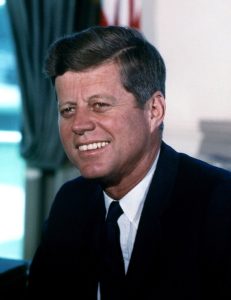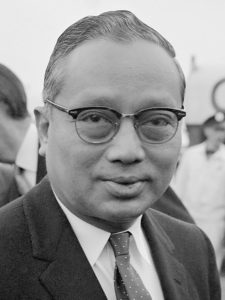Editor’s Note: This the third part of Thomas Gotowka’s series titled “Great Leaders and Great Speeches.’ The previous three parts can be found at these links:
A View from My Porch: Great Leaders and Great Speeches, Part 1
A View from My Porch: Great Leaders and Great Speeches, Part 2
A View from My Porch: Great Leaders and Great Speeches, Part 3: The Cold War
Part 3 concluded with President Kennedy’s humiliation with the disaster at the Bay of Pigs, which served to strengthen Castro’s government; and resulted in Cuba’s adoption of communism, and their development of close ties with the Soviet Union.
This essay is a review of two weeks in 1962 that brought the world dangerously close to nuclear war. In the next essay, I will explore the “Visuals” of that period: What were anxious Americans reading and watching during that tense era? I will then review the gradual “wind-down” of Cold War hostilities, and the collapse of the Soviet Union in a following essay.
My goal with these essays is that the reader gets a solid foundation in the fundamentals of the subject matter, which may even pique their curiosity enough to seek additional information.
The Cuban Missile Crisis Thriller:
Fidel Castro was so certain that the United States would make another attempt at military intervention after the Bay of Pigs that he looked to the Soviet Union for military assistance, which they eagerly provided.
Consequently, during routine surveillance flights over the island in September 1962, U.S. Intelligence found evidence of a general Soviet arms build-up on Cuba, including Soviet IL–28 bombers.
 So, on Sept. 4, 1962, President Kennedy issued a public, televised warning against the introduction of offensive weapons on Cuba. Our Intelligence services had also discovered that, in July, Soviet Premier Nikita Khrushchev had reached an agreement with Castro to place Soviet nuclear missiles in Cuba to “deter” any future invasion attempt.
So, on Sept. 4, 1962, President Kennedy issued a public, televised warning against the introduction of offensive weapons on Cuba. Our Intelligence services had also discovered that, in July, Soviet Premier Nikita Khrushchev had reached an agreement with Castro to place Soviet nuclear missiles in Cuba to “deter” any future invasion attempt.
Despite the warning, photographs taken by a high-altitude U-2 spy plane over Cuba on Oct. 14 provided indisputable evidence that several missile sites were under construction and nearing completion. These sites could house Soviet medium-range missiles, capable of carrying nuclear warheads, and striking many major cities in the United States, including Washington, DC.
The President convened an emergency meeting of his senior military, political, and diplomatic advisers to discuss these developments and determine America’s response. He ruled out a “surgical” military strike early in the deliberations, concerned that it could miss some of the missile sites and would prompt Soviet retaliation, probably against a vulnerable West Berlin.
In lieu of the military strike, Kennedy and his advisers decided on a Naval quarantine and a “very strong” demand by the President that the bases be dismantled and missiles removed.
In an extraordinarily grave televised speech on Oct. 22, the President revealed the discovery of these missile bases to the American people.
“This Government, has maintained close surveillance of the Soviet military buildup on the island of Cuba. Within the past week, unmistakable evidence has established that a series of offensive missile sites is now in preparation on that ‘imprisoned’ island. The purpose of these bases can be none other than to provide a nuclear strike capability against the Western Hemisphere.”
Then, and evocative of the Monroe Doctrine, he continued with, “It shall be the policy of this nation to regard any nuclear missile launched from Cuba against any nation in the Western Hemisphere as an attack by the Soviet Union on the United States, requiring a full retaliatory response upon the Soviet Union.”
He announced that he was ordering a Naval “quarantine” of Cuba to prevent Soviet ships from transporting any additional offensive weapons to the island, and again affirmed that the United States will not tolerate these missile sites on Cuba. Kennedy said America will not stop short of military action to end this “clandestine, reckless, and provocative threat to world peace.”
Although he had no experience in “reality TV”, Kennedy was highly skilled in the use of that medium to communicate with Americans. He had already demonstrated his presence and poise in the televised debates with then opposing presidential candidate, Richard Nixon.
The quarantine began on Oct. 23 and, after a few tense days, Soviet ships appeared to reduce speed or change course as they approached the quarantine “line.”

United Nations Secretary-General U Thant appealed privately to both Kennedy and Khrushchev at the request of more than 40 non-aligned nations and urged them to “refrain from any action that may aggravate the situation and bring with it the risk of war.”
In what turned into an amazing confrontation on Oct. 25, the usually soft-spoken and consummate diplomat, Adlai Stevenson addressed the United Nations Security Council on “Soviet Missiles in Cuba.”
In response, Soviet ambassador Zorin laced into the United States’ “lies” at great length, and refused to confirm or deny Stevenson’s allegations.
Stevenson responded, “I want to say to you, Mr. Zorin, that I do not have your talent for obfuscation, for distortion, for confusing language, and for doubletalk. And I must confess to you that I am glad that I do not!” Stevenson went on to denounce the Soviets for lying, and said he was prepared to wait for an answer on these missiles, “until hell freezes over, if that is your decision; and I am also prepared to present the evidence in this room.”
Zorin still refused to answer, and Stevenson’s aides placed large U-2 photographs of the Soviet missiles on easels around the room. The delegates in the room, and anyone watching the television coverage, were witness to the Soviets’ brazen provocation. The mild-mannered Stevenson had scored an enormous political and diplomatic victory for the United States. His dramatic and forceful exposure of Soviet duplicity ensured increased international pressure for them to back down.
During this crisis, our military forces went to DEFCON 2 & 3, the highest military alerts ever reached after WWII; and the military prepared for full-scale war with the Soviet Union.
On Oct. 26, the President learned that work on the missile bases was proceeding without interruption, and he considered authorizing bombing and an invasion of Cuba.
However, now under international pressure, the Soviets conveyed a proposal to the President to end the crisis: the missile bases would be removed in exchange for a pledge by the United States to not invade Cuba. They then increased their demands by calling for the dismantling of our missile bases in Turkey, which threatened the Soviet Union. Note that Kennedy and Kruschev communicated directly throughout the crisis.
While Kennedy and his team debated this turn of events, a U-2 spy plane was shot down over Cuba. To the dismay of his military advisers, Kennedy prohibited any military retaliation unless another surveillance plane was fired upon over Cuba.
To defuse the worsening crisis, Kennedy agreed to dismantle the missile bases, but at a later date; which he felt would prevent Turkey, a key NATO member, from protesting.
Finally, on Oct. 28, Khrushchev announced his government’s intent to dismantle and remove all offensive Soviet weapons from Cuba. and the United States stepped back from the brink of nuclear war.
Kennedy called off the quarantine in November, and by year’s end, removed our missiles from Turkey. The removal of what were obsolete Jupiter missiles had no detrimental effect on U.S. nuclear strategy.
The crisis was over, but the danger of nuclear war in the future had not abated.
Unfortunately, after shutting down their missile bases on Cuba, a humiliated Soviet Union began a massive nuclear buildup and eventually reached nuclear parity with the United States in the 1970s. They also built intercontinental ballistic missiles capable of striking any city in the United States.
I believe the following statement from President Kennedy illustrates his guiding principles in resolving this crisis: “Neither the United States of America nor the world community of nations can tolerate deliberate deception and offensive threats on the part of any nation. We no longer live in a world where only the actual firing of weapons represents a sufficient challenge to a nation’s security to constitute maximum peril.”
Kennedy continued, “Nuclear weapons are so destructive and ballistic missiles are so swift, that any substantially increased possibility of their use or any sudden change in their deployment may well be regarded as a definite threat to peace.”
Some Final Thoughts:
As I refreshed my memory of the Cold War era, I couldn’t help but consider Edmund Burke’s warning, which seems very relevant in light of the evidence of foreign interference in the 2016 election, and recent allegations of bounties in Afghanistan. Burke said “Those who don’t know history are doomed to repeat it.”
Kennedy’s interactions with his advisers had changed after the Bay of Pigs. He began to challenge their suggestions and insights to a much greater degree, and he demanded more options and better estimates of possible outcomes. Certainly, in this current COVID-19 crisis, we should better recognize what Adlai Stevenson characterized as “obfuscation, distortion, confusing language, and doubletalk” in our leaders.
Kennedy had been in office less than two years at the beginning of this crisis. However, he clearly demonstrated how great leaders must act in times of overwhelming crisis — accept responsibility, challenge your trusted advisers, communicate, and value your “intelligence gatherers”, but verify.
Kennedy’s strategic use of “quarantine” distinguished his action from a “blockade”, which assumes a state of war; and also enabled the United States to receive the support of the Organization of American States.
A succession of United States’ Administrations honored Kennedy’s pledge to not invade Cuba, but relations with them remained a “thorny” issue for our foreign policy until 2015, when formal “normalization” of relations occurred.
Unfortunately, the current Administration has not seen fit to honor prior agreements and alliances.
If you have any interest in the “art and science” of decision- making, I recommend The Essence of Decision: Explaining the Cuban Missile Crisis, by Graham T. Allison, who used the crisis as a case study for future analyses of governmental decision-making. The book became the founding study of Harvard’s John F. Kennedy School of Government.
God save the United States.
This is the opinion of Thomas D. Gotowka.

About the author: Tom Gotowka’s entire adult career has been in healthcare. He’ will sit on the Navy side at the Army/Navy football game. He always sit on the crimson side at any Harvard/Yale contest. He enjoys reading historic speeches and considers himself a scholar of the period from FDR through JFK.
A child of AM Radio, he probably knows the lyrics of every rock and roll or folk song published since 1960. He hopes these experiences give readers a sense of what he believes “qualify” him to write this column.
A good summary on historic events. JFK demonstrated that strong, honest, logical, reasonable, and data driven leadership is an effective way to maintain a firm policy and avoid crisis. He wasn’t focused on furthering political agendas, but at arriving at the best solution for everyone.
Thank you for this nicely constructed review of a significant moment from my early days. I was 10 years of age when this occurred and recall listening to JFK’s Oct. 22nd speech on the car radio. It was indeed, a frightening time.